

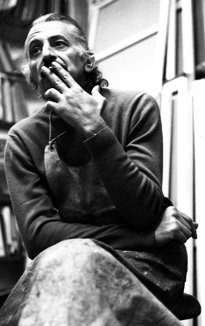
© Chantal Marfaing
1926-1944
Shafic Abboud was born on the 22nd November 1926 in a Greek Orthodox village called Mhaidsé, in the Lebanese mountains, approximately 20 km. north-east of Beirut. His family’s origins were profoundly rural, yet his father, Boutros, had a successful business in Beirut and his mother, Emilie, was able to pursue her studies, coming from a middle class background. Shafic was the eldest of his siblings and had a brother, Sami, and a sister, Sonia.
His childhood remained an enchanted and delightful period of his life. The memories of a grandmother who was the village’s story-teller, of a grandfather who was a peasant but also a poet-illustrator, of the light, the huts in the trees, the Melkite iconography, were all going to endlessly fuel the artist’s imagination throughout his life. He later referred to this period as the “the bird’s years”.
During his adolescence, Shafic Abboud was a student of the Christian Brothers in Beirut, being both hard-working and undisciplined. Having started to paint at an early age, his encounter with the Post-Impressionist Lebanese painter César Gemayel when he was 15 years old was crucial for his career as an artist.
In 1944, his father registered him at the French School of Engineers in Beirut, where he moped around for two years, recalling that: "… painting was consuming me more and more and everything else I was doing became indifferent to me. There is always a bit of madness in what we undertake and most certainly a cleft somewhere…" (1).
Abboud dropped out of the course and registered at the Lebanese Academy of Fine Arts, founded by César Gemayel. The atmosphere was exciting, yet the teaching methods were too academic for him. He therefore decided to leave Lebanon.
1947-1950
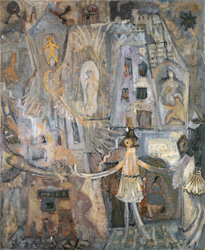
Oil on board - 1948
Abboud returned to Lebanon in the autumn of 1949, but it was soon obvious to him that he needed to quickly leave again. His entire life would be accentuated by regular back and forths to Lebanon, a duality sometimes serene and other times harsh. He worked on his paintings and inaugurated his first solo exhibition in Beirut in December 1950, with the help of the French painter Georges Cyr. His paintings were at that time still figurative.
1951-1954
By March 1951, Abboud had gathered enough money to pay his trip and to be able to live some time in Paris. He settled in a small studio next to the Montsouris park, immersed in the intellectual and artistic life, and resumed studying with Lhote, Metzinger, Friesz and Léger. He registered again at the School of Fine Arts and this time attended classes of graphic techniques with Heuze, the lithographer Jaudon and Goerg. It was in the latter’s studio that Abboud would produce the engravings for Le Bouna, the first painter’s book made by an Arab artist.
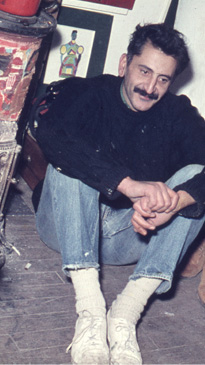
© Shafic Abboud
Abboud established himself as a painter, shifting decisively towards abstract art. He took part in all the discussions organized by Estienne and Degand, travelled a lot and went to many exhibitions and museums day after day.
The year 1954 was a turning point in the artist’s life, as he met the art critic Roger van Gindertael. The latter was the co-founder of the Journal Cimaise as well as being one of the first to write essays on Nicolas de Staël and Hans Hartung, and who defended many artists’ views, such as Nallard, Gauthier, Bissière, Lanskoy, Bryen. This was the beginning of a key relationship of both friendship and business.
1955-1958
With Gindertael’s support, Shafic Abboud had his first Parisian exhibition at the Galerie de Beaune in February 1955. He was invited to the Salon des Réalités Nouvelles, to which he participated throughout his life and, a few years later, he became a member of its committee.
His father’s death in March 1957 cast a dark shadow over this period, yet the group exhibitions followed one another in Paris, at the Iris Clert and Suzanne de Coninck galleries, as well as abroad at the biennials of Lissone, Düsseldorf and Essen.
1959-1963
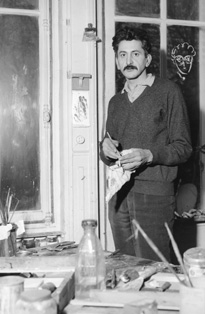
© Lucien Petit-Jean
Then he was invited to take part to the First Biennial of Paris in the French section entitled “the young critics’ choices”, amongst whom figured Boudaille, Conil-Lacoste, Descargues, Ragon, Restany, Weelen and Taillandier.
Finally, the year 1959 culminated with the signature of an exclusivity contract with the Raymonde Cazenave Gallery. This four-year collaboration proved to be highly successful yet at the same time very difficult, due to the numerous restrictions imposed by the agreement’s clauses; it would change Abboud’s relationship with art dealers forever. Several solo exhibitions were organized and during his group shows, Abboud’s paintings were presented side by side with works by Bryen, Hartung, Dumitresco, Lanskoy, Villon, Estève, ...
A few years earlier, one of his closest friends, the composer André Boucourechliev, introduced Abboud to Nicole de Maupéou, who was a young sociologist working with Alain Touraine. Shafic and Nicole married in 1961 and they brought up together Dominique, Nicole’s daughter born from her previous marriage, and Christine, who was born in 1962.
The next few years, Abboud went travelling again this time to Germany, feeling the need to improve his training as a lithographer there. He became more and more interested in print techniques and hence purchased his own press machine in order to produce his own impressions. He explored engraving on copper, on zinc, with linocuts, drawing on stone, … He worked with Mourlot and in some of the most prestigious studios, travelling frequently to Holland and Belgium, where he became an artist in residence in art centers.
This bond with producing ‘multiples’ is closely related with the artist’s love for books. Abboud illustrated the poems of Adonis and the picaresque stories reminiscent of the oriental tradition Maqâmât Al-Harîri. He produced himself his books Le Bouna, La Souris, Hamacs, Le Livre de la Difficulté et du Bonheur, and always worked on other projects at the same time.
1964-1968
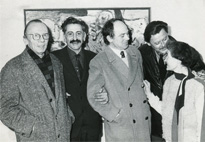
La Roue Gallery 1967
He participated to many exhibitions in Germany, Algeria, Denmark and Holland, alongside Debré, Karskaya, Messagier, Miotte, Moser, Nallard and Rebeyrolle, with whom he tried to create an artists’ group. He also took part in the Salons Schèmes and Comparaisons.
The woman artist Karskaya, who was to become one of Abboud’s close friends, collaborated with him on a series of portraits entitled Connus-inconnus in 1967. During the 1968 May incidents, they worked together on pieces with four hands, known as Cousus-mains, yet this collaboration would never occur again with any other artist.
The Museum of Fine Arts in Paris and the State (CNAC) acquired two paintings by Abboud.
1969-1975
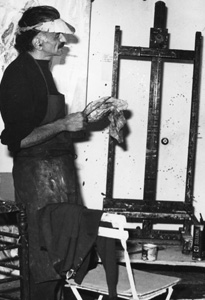
© Alain van Gindertael
He bought a small studio in the same area of the Montsouris park. He then travelled to Belgium and Holland, where he met Michèle Rodière, his future partner.
Nonetheless, a heavy psychic suffering also bore upon those years. His doubts on whether he could pursue his career as a painter relentlessly tormented him and his personal life was tearing him apart, inducing him to make a suicide attempt in October 1973.
However, it did not stop him from working and many exhibitions took place at that time, not only in Lebanon, such as at the Janine Rubeiz Gallery, the Manoug Gallery and the Art Centre directed by Brigitte Schéhadé, but also in France and Holland, at the Protée Gallery in Toulouse and the de Boer Gallery in Amsterdam.
1976-1980
Abboud initiated a series of exhibitions with Brigitte Schéhadé who soon opened a gallery in Paris. He also worked with the Principe Gallery and remained loyal to Protée and de Boer.
The Jeanne Bucher and Ariel Galleries hosted a show entitled “65 painters witnessing their friendship for Roger van Gindertael”, an ambitious project with which Abboud was very much involved.
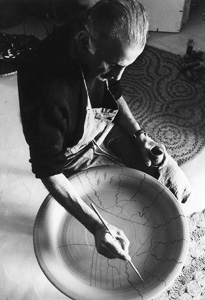
© Gérard Khoury
1981-1990
1981 was the year Shafic Abboud returned to Lebanon, after a five-year gap due to the war. The following year was a year of mourning, as his mother passed away in February 1982 and a few months later, Roger van Gindertael, his “spiritual” father, also died. For some time, it seemed that Abboud’s work was turning back to his childhood, and it was only later that he resumed his study of classical Arabic.
In 1983, the journal Cimaise not only dedicated its front cover to Abboud but it also published an illustrated article, including a text by Gilles Plazy. The Faris Gallery exhibited his works at the FIAC in 1983, 1984 and 1988, as well as also organizing for him two solo exhibitions. Abboud’s paintings were also present at the FIAC on the Protée Gallery’s stand in 1983 and 1986.
At that time, Abboud worked a lot with large-sized canvases, mainly focusing on two critical series, the Chambres (Rooms) and the Nuits (Nights). The Faris Gallery offered Abboud to host a retrospective exhibition of his oeuvre from 1948 to 1998.
He also participated to various exhibitions at the Institut du Monde Arabe, in London as well as in Denmark, continuing with his tireless lithographic work.
1991-2004
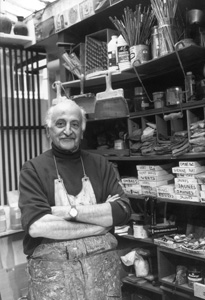
© Wolfgang Osterheld
In 1994, the Janine Rubeiz Gallery organized its first solo exhibition for Abboud in Beirut, after a break of sixteen years of war. He stayed several weeks in Lebanon and travelled to Damascus and Aleppo.
Back in Paris, he exhibited at the Maison de l’UNESCO, the Institut du Monde Arabe and at the Protée Gallery. Between 1997 and 2003, the Claude Lemand Gallery organized several solo exhibitions of Abboud’s works.
Abboud’s last solo exhibition in Lebanon was held at the Janine Rubeiz Gallery in 1999.
In 1997, Shafic Abboud had a violent stroke, which was the first of a series from his fatal heart disease. Weakened by the strokes day after day, Abboud passed away on 8th April 2004 in Paris. He was buried in his home village Mhaidsé.
Translated from French by Valérie Hess
(1) Revue du Liban, 4th March 1972
© 2011 - www.abboud-retrospectives.org - Adagp - Editions CLEA


